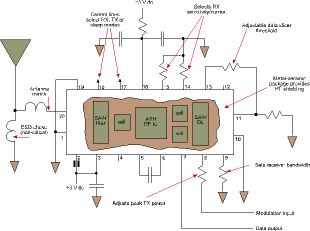
RF Monolithics' second-generation short-range radio product line includes miniature transmitter, receiver and transceiver hybrids, plus OEM data radio boards and related protocol firmware and development kits.
These products are used to implement short-range wireless data communication and control links in a wide range of applications. The product line supports the most popular UHF frequencies used in all major world markets.
RFM's short-range radio products are based on an enhanced version of its proprietary amplifier-sequenced hybrid (ASH) radio architecture. This technology has been specifically developed to provide the features needed by modern short-range data radio applications:
* Data rates up to 115,2 Kbps for data, control and digitised voice transmissions.
* Stable, sensitive receiver technology with good 'channel capture' performance.
* Low current consumption for operation from small 3 V batteries.
* Very small, low-profile package to make 'watch size' applications practical.
* Integrated quartz SAW filtering and frequency control components.
* Rugged, shelf-shielding, metal-ceramic hybrid package.
* Wide operating temperature range for industrial and outdoor applications.
* Easy to optimise for a wide range of application requirements.
* Easy certification to stringent short-range radio regulatory requirements.
Integrated hybrid package
Integrating the RF IC with its SAW filtering and frequency control devices in a single hybrid simplifies and speeds up the user's RF design task. No external RF filters, IF filters, resonators or crystals are required. All critical interconnections are implemented within the self-shielding hybrid package. Second-generation ASH radios are optimised for a given application by selecting noncritical baseband and antenna tuning components.
ASH technology
The heart of the ASH radio technology is the amplifier-sequenced receiver section which provides over 100 dB of stable RF and detector gain. Stability is achieved in an ASH receiver by distributing the total RF gain over time. This is in contrast to a superheterodyne receiver which achieves stability by distributing total RF gain over multiple frequencies.
Figure 1 shows the basic block diagram and timing cycle for an amplifier-sequenced receiver architecture. The bias to RF amplifiers RFA1 and RFA2 are independently controlled by a pulse generator, and the two amplifiers are coupled by a surface acoustic wave (SAW) delay line which has a nominal delay of 0,5 µs.

An incoming RF signal is first filtered by the narrow-band SAW filter and is then applied to RFA1. The pulse generator turns RFA1 on for 0,5 µs and the amplified signal from RFA1 emerges from the SAW delay line to the input of RFA2. RFA1 is then switched off and RFA2 switched on for 0,55 µs, amplifying the RF signal further. Since the on time for RFA2 is set at 1,1 times the on time for RFA1, the filtering effect of the SAW delay line stretches RFA1's signal pulse. RFA1 and RFA2 are not on at the same time and this assures excellent receiver stability. The SAW filter and delay line act together to provide very high receiver ultimate rejection.
Amplifier-sequenced receiver operation has several interesting characteristics that can be exploited in system design. The RF amplifiers in an amplifier-sequenced receiver can be turned on and off almost instantly, allowing for very quick power-down (sleep) and wake-up times. Also, both RF amplifiers can be off for a period between ON sequences to trade-off receiver sensitivity for lower average current consumption.
The flagship of the second-generation ASH radio product line is the ASH transceiver which addresses the rapidly growing requirement for short-range, two-way data communications.
The same ASH technology for the transceiver is used in the ASH transmitter and receiver hybrids to support demanding one-way control and telemetry applications. All second-generation ASH radios utilise a standardised 20-pin layout (Figure 2). This makes it possible to do a single PCB layout and build it as a transmitter, receiver or transceiver.


© Technews Publishing (Pty) Ltd | All Rights Reserved